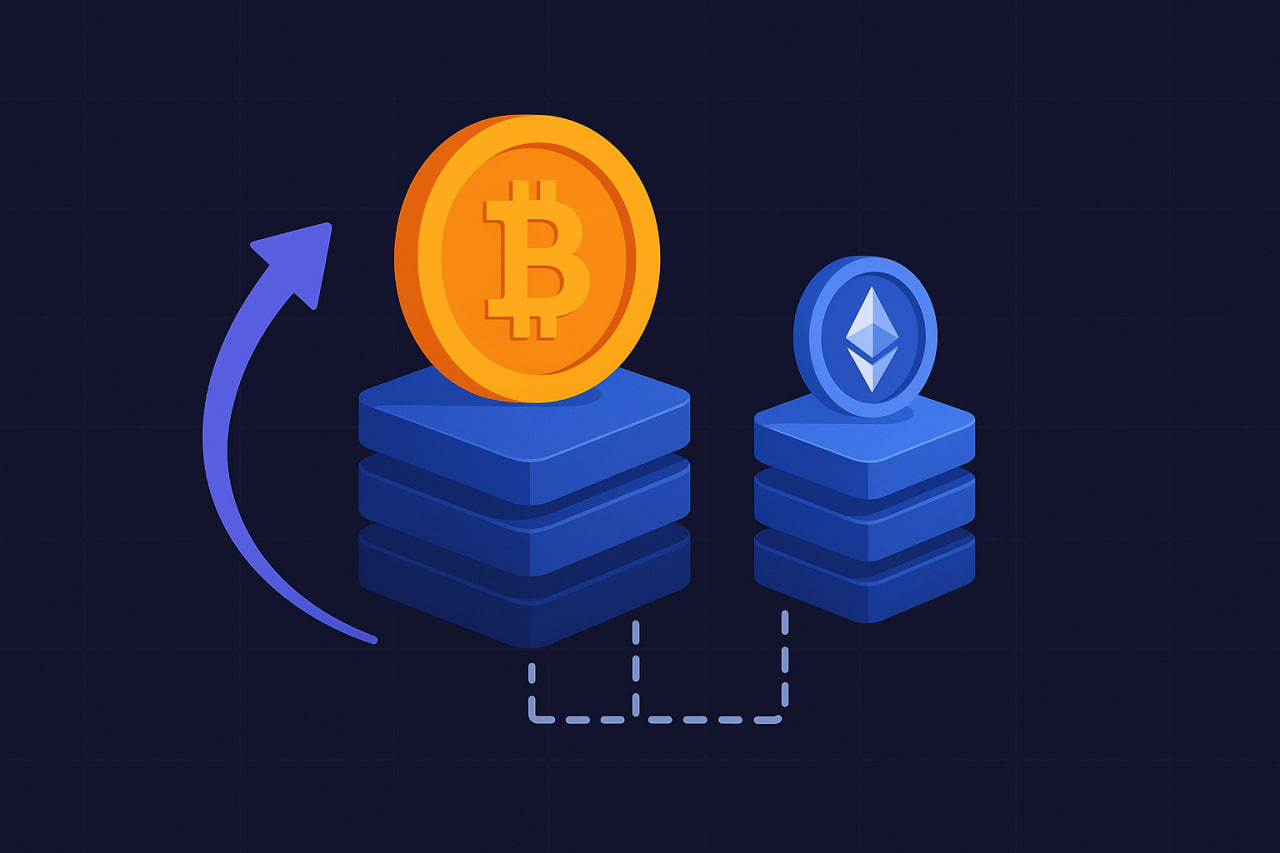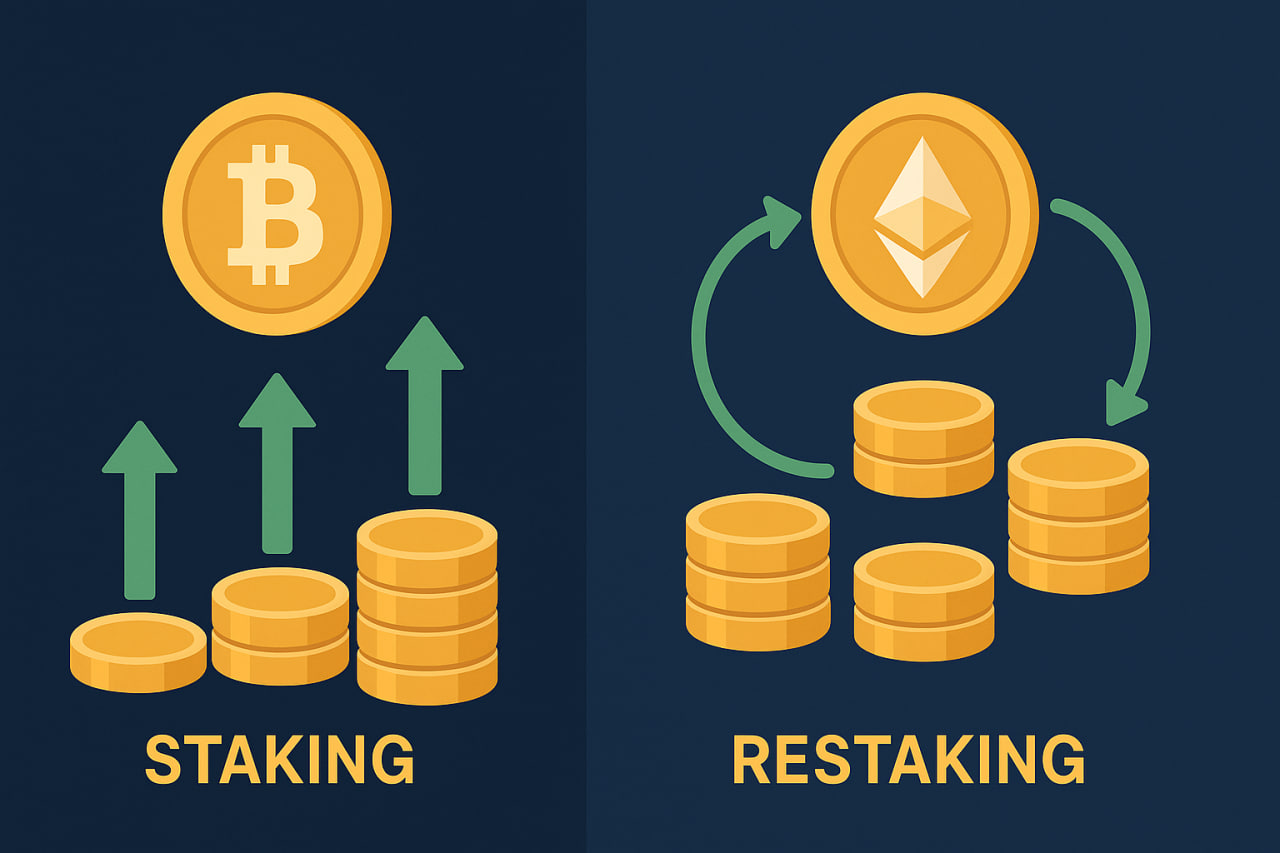What is restaking?

Contents
- Introduction
- What is Restaking
- How Restaking Works
- Difference Between Staking and Restaking
- Benefits of Restaking for Investors
- Risks and Drawbacks of Restaking
- Examples of Restaking Protocols
- Restaking in the Ethereum and DeFi Ecosystem
- Future of Restaking and Market Prospects
- Conclusion
Introduction
Restaking is a relatively new concept in the world of cryptocurrencies and decentralized finance (DeFi), which is actively discussed among investors and developers. It allows for the maximisation of staked assets to generate additional yield or enhance blockchain security. With the growth of DeFi and increasing interest from institutional players, the concept of restaking is gaining more significance.
What is Restaking

Restaking is the process of redelegating already staked tokens to participate in additional protocols or services. The main idea is that a token already securing the network can be reused to earn new rewards or strengthen blockchain protection.
Key features of restaking:
-
The ability to use the same token across multiple protocols simultaneously.
-
Increased overall yield by combining rewards.
-
Enhanced network security through additional validator verification.
How Restaking Works
The mechanics of restaking are relatively simple but require an understanding of blockchain structure and validators.
-
A user stakes tokens on the base blockchain.
-
Some of these tokens or their liquid derivatives (LRT — Liquid Restaked Tokens) are delegated to another protocol for additional rewards.
-
The protocol verifies validators using the restaked tokens, increasing network security.
-
The user receives a combined yield from the base staking and additional protocols.
Table 1. Comparison of Yield and Risks: Staking vs Restaking
| Parameter | Staking | Restaking |
|---|---|---|
| Potential Yield | Medium | High |
| Risk Level | Low | Medium/High |
| Token Usage | One protocol | Multiple protocols |
| Liquidity | Limited | Increased |
Difference Between Staking and Restaking

Classic staking and restaking share similarities but differ in key aspects:
-
Yield: Restaking allows earning additional rewards by reusing tokens.
-
Risk: Restaking carries higher risks due to extra smart contracts and protocols.
-
Liquid Tokens: LRTs are actively used in restaking for more flexible capital management.
-
Network Impact: Restaking enhances decentralised security by strengthening the role of validators.
Benefits of Restaking for Investors
Investors and traders see several key advantages in restaking:
-
Increased potential yield without additional investment.
-
More efficient capital use through redelegation of tokens.
-
Participation in the growth of new DeFi protocols and ecosystems.
-
The ability to combine staking rewards with restaking protocol rewards.
Risks and Drawbacks of Restaking

Despite its attractive opportunities, restaking carries certain risks:
-
Technical vulnerabilities in smart contracts used by restaking protocols.
-
Capital concentration among a limited number of providers, reducing decentralization.
-
Potential losses due to high cryptocurrency volatility.
-
Complexity of managing and monitoring multiple protocols simultaneously.
Examples of Restaking Protocols
Notable platforms supporting restaking include:
-
EigenLayer — one of the first protocols offering redelegation of ETH for additional protection and yield.
-
Lido — enables the use of staked tokens in DeFi through derivative tokens.
-
Rocket Pool — allows validators to increase yield by delegating to other protocols.
Restaking in the Ethereum and DeFi Ecosystem
On Ethereum, restaking is actively integrated with existing DeFi protocols. Validators can delegate their ETH or LRTs across multiple protocols, strengthening security and increasing yield. This leads to greater decentralisation and network reliability, while users gain the opportunity to participate in new protocols and services.
Future of Restaking and Market Prospects

The number of platforms and tools for restaking is expected to grow. Likely developments include:
-
The emergence of new financial instruments based on LRTs.
-
Increased interest from institutional investors.
-
Broader adoption of restaking in PoS blockchain ecosystems.
-
Higher overall liquidity and yield in the DeFi sector.
Conclusion
Restaking is a promising trend in cryptocurrencies and DeFi, allowing staked assets to be used more effectively for higher yield and stronger network security. However, investors must consider technical and financial risks. Thoughtful application of restaking opens new opportunities for market participants and contributes to the growth of the Ethereum and DeFi ecosystems as a whole.